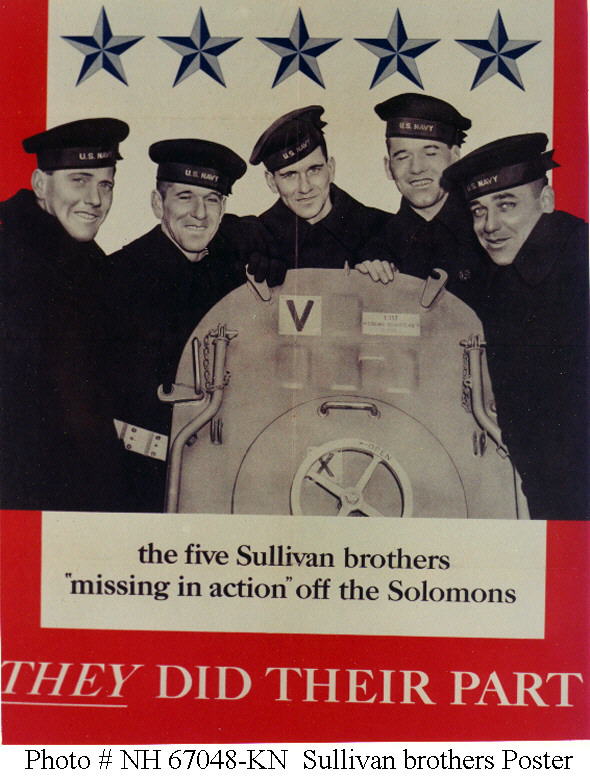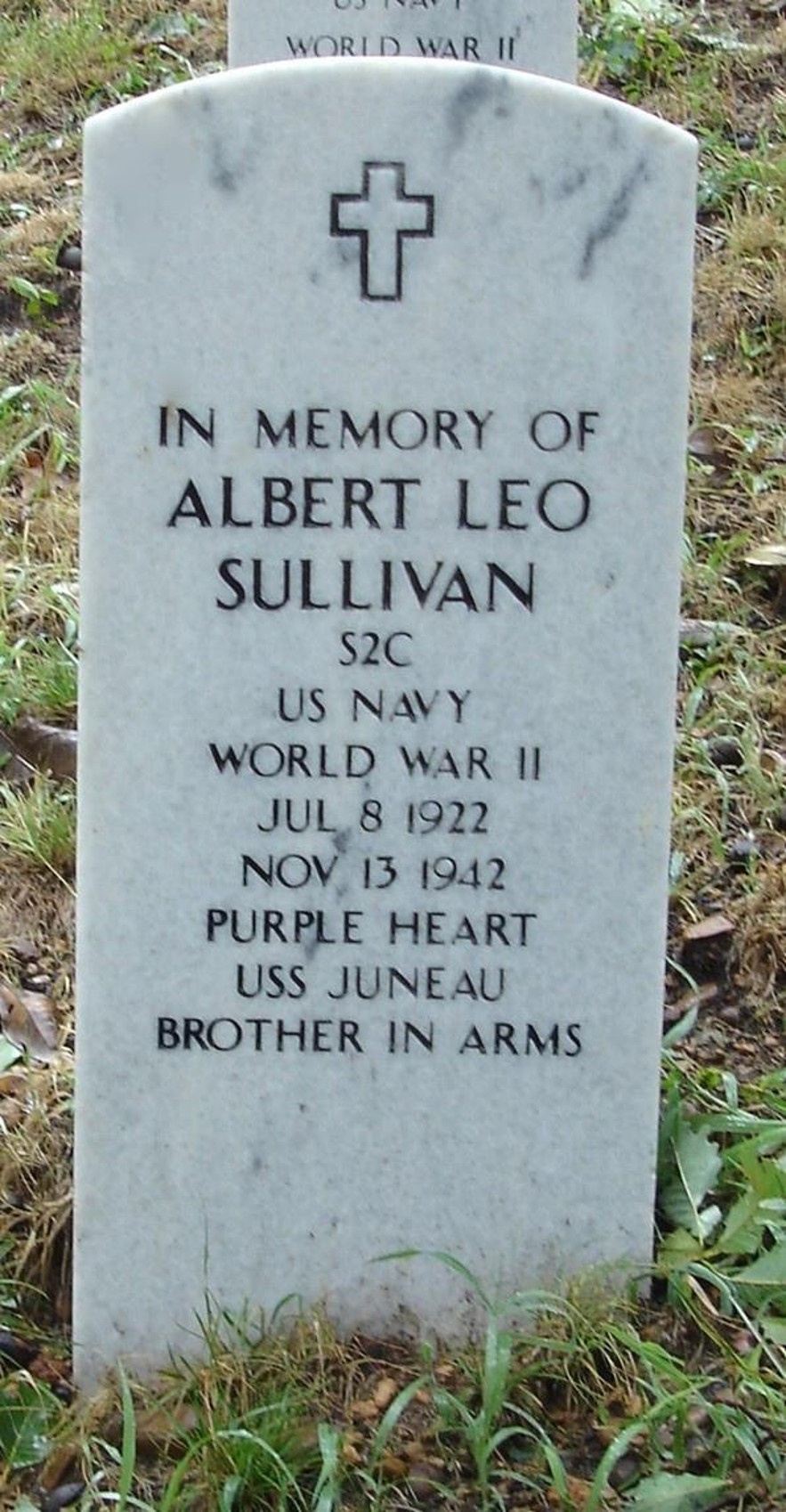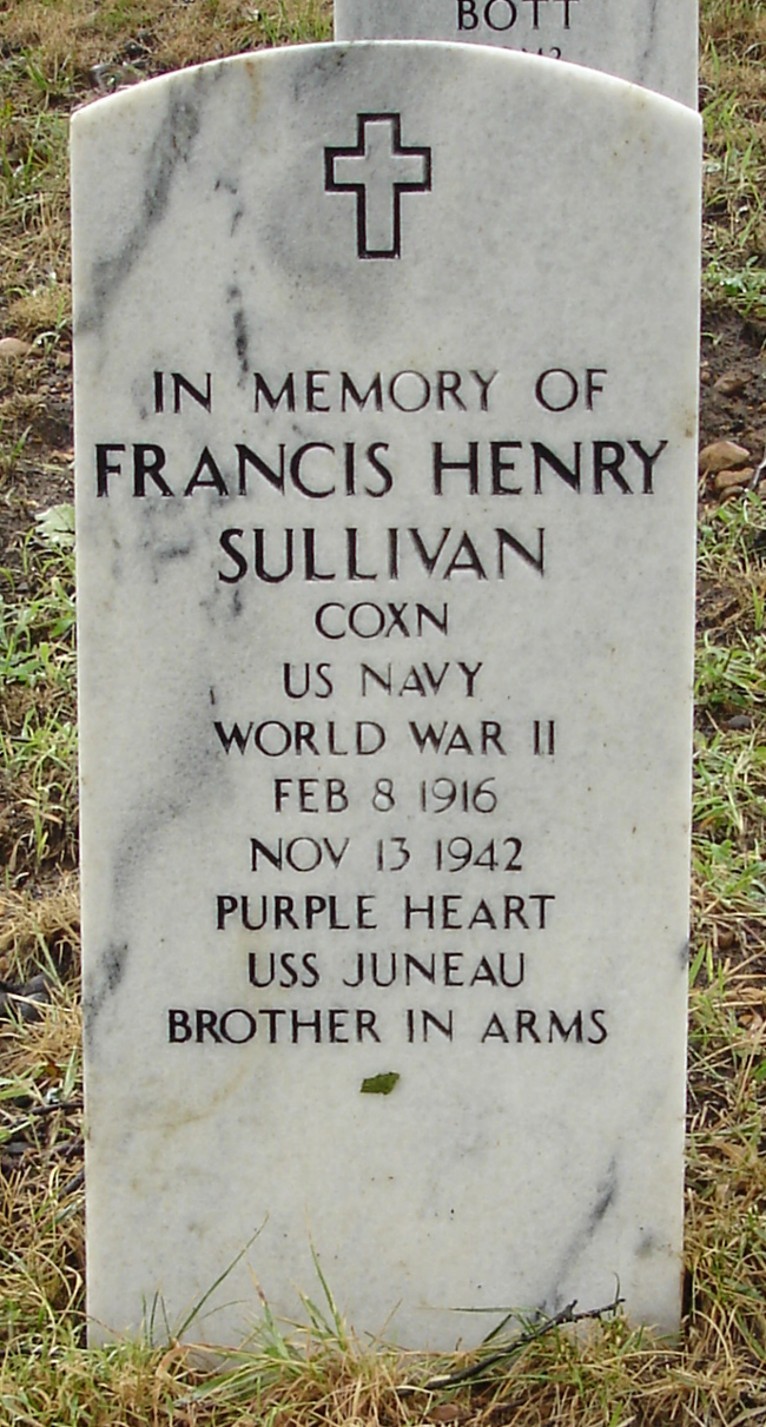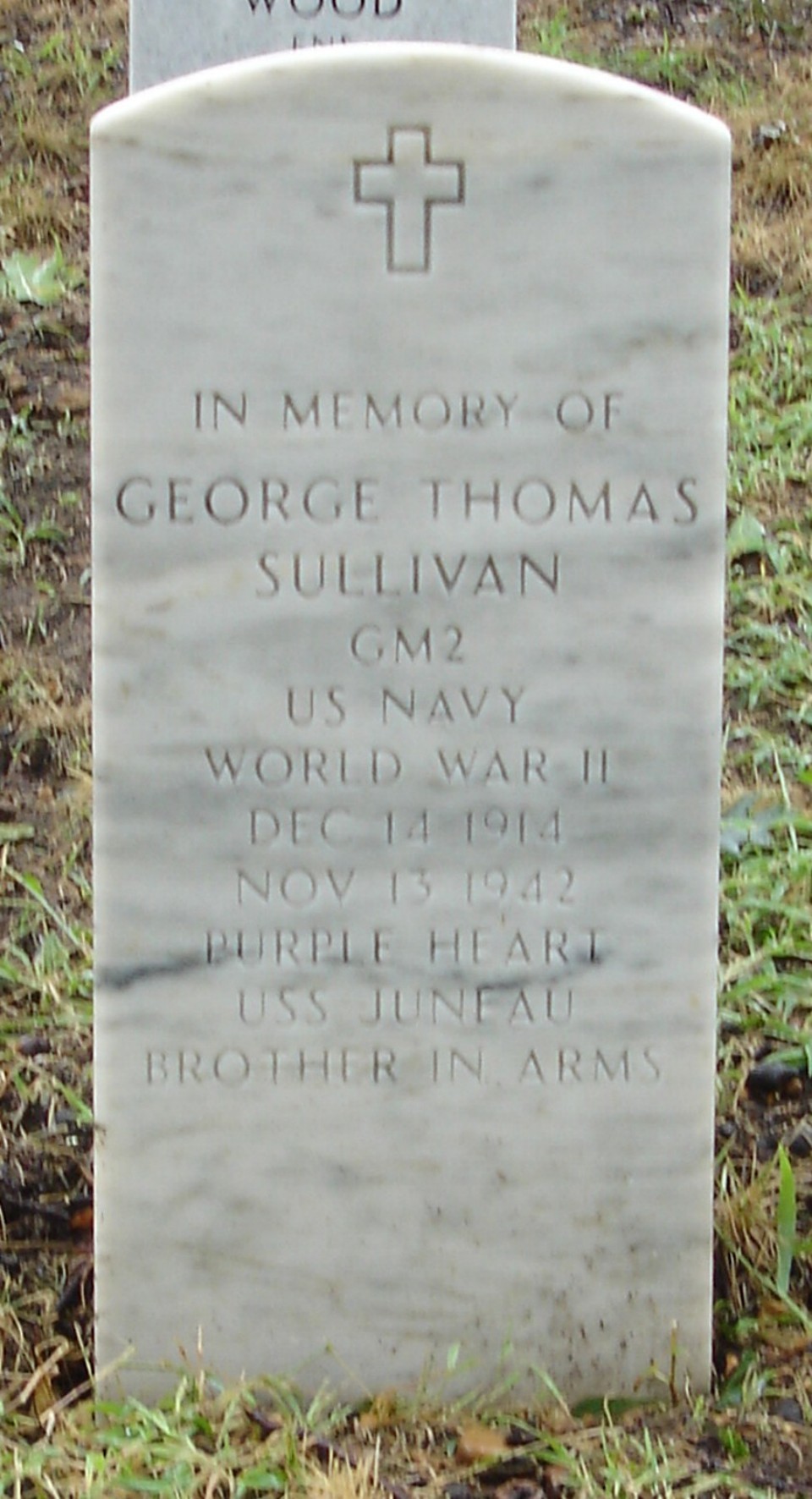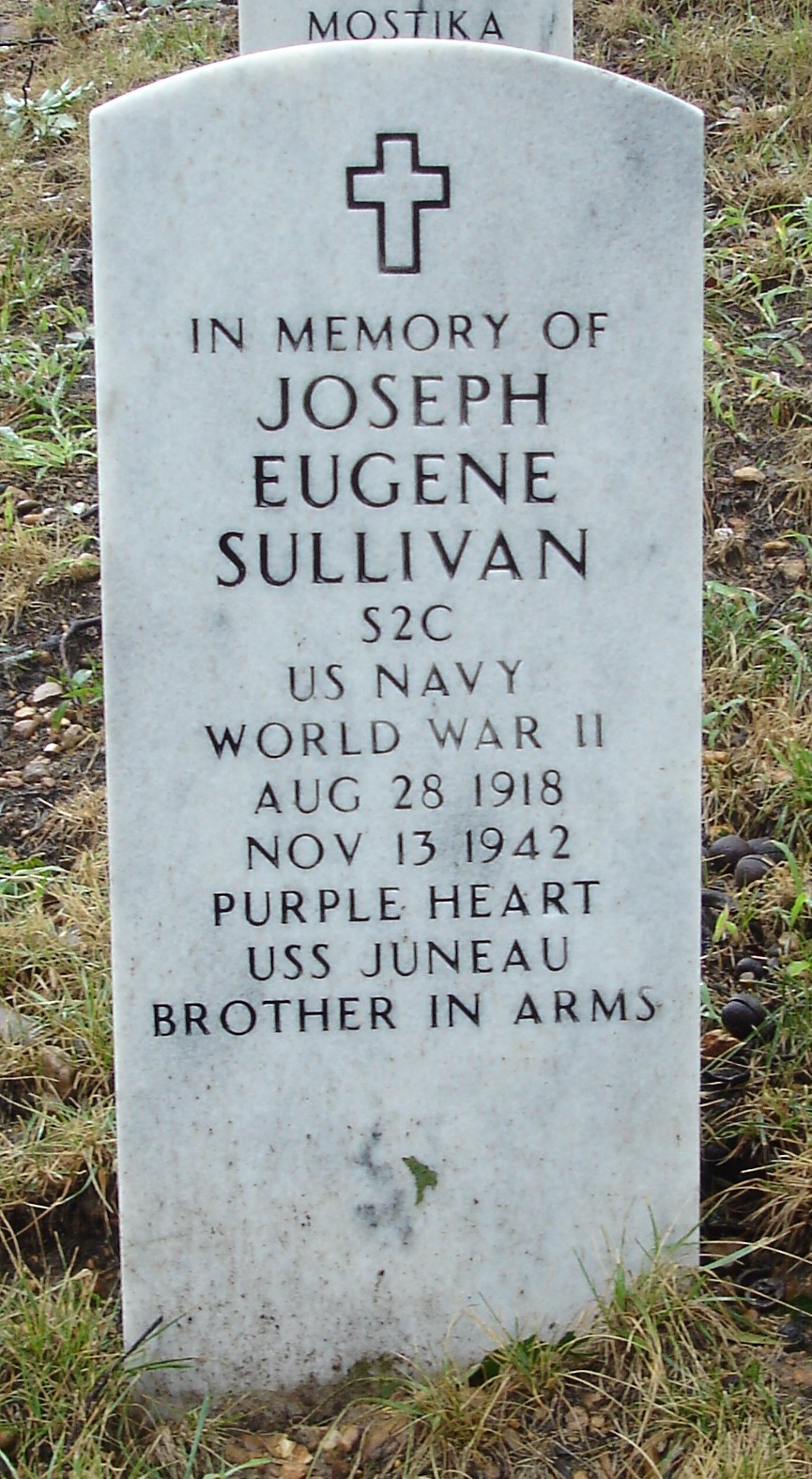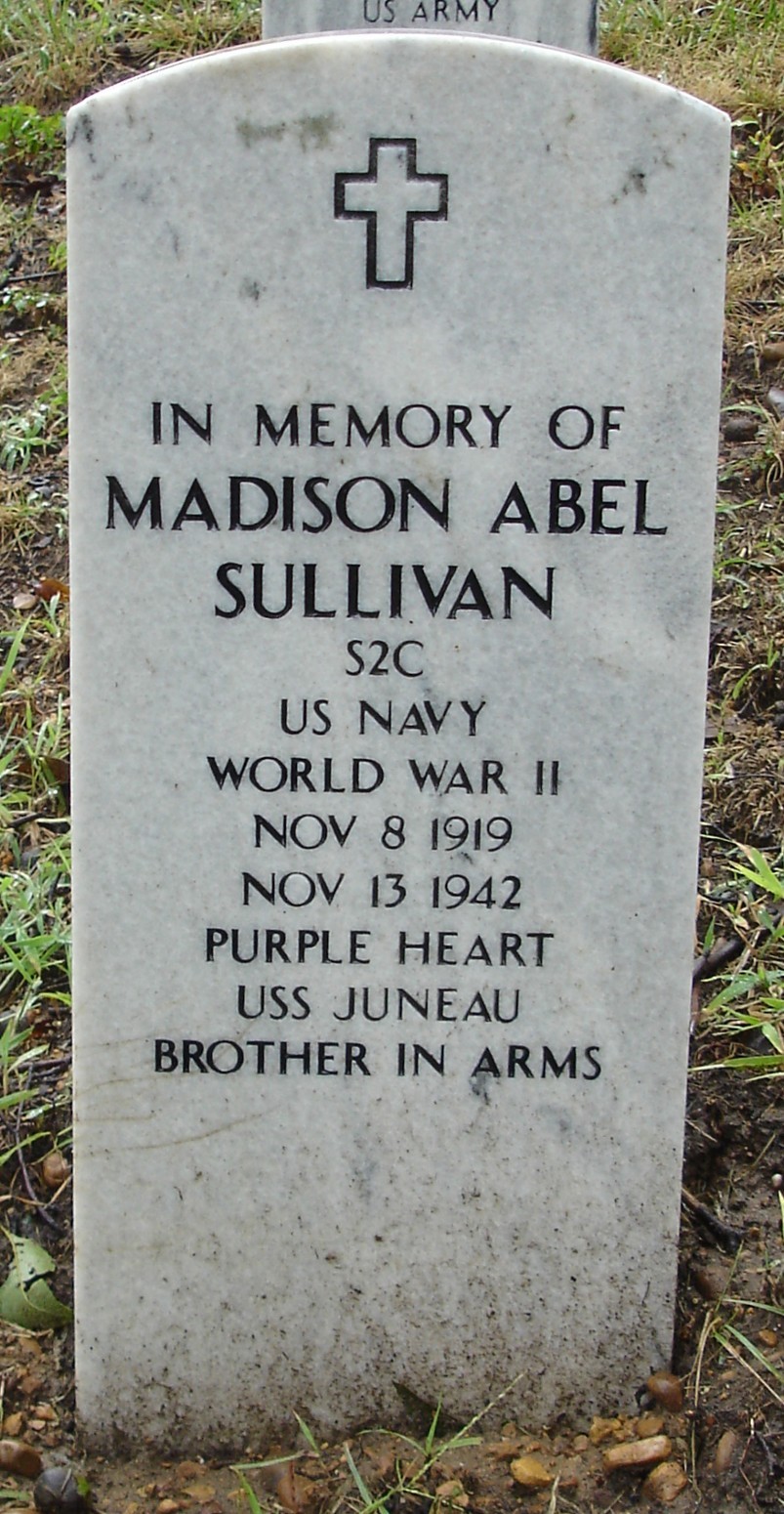The Sullivan Brothers of Waterloo, Iowa
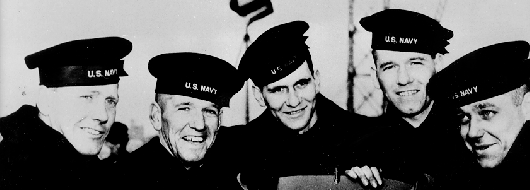
A large U.S. Navy task force left New Caledonia on November 8, 1942 to bring reinforcements and supplies to the beleaguered Marines at Guadacanal. At the same time the Japanese had sent a contingent of their navy to resupply their army on the other side of the Island. On November 12th the American ships and Marine aircraft destroyed an attacking Japanese group of aircraft. One of the U.S. vessels was the light Cruiser, the Juneau.
Waterloo, Iowa had a population of less than 50,000 in 1942. Among that number were the eight members of the Sullivan family who lived at 98 Adams St. Thomas F. Sullivan, the head of the family, worked for the Illinois Central railroad. He was named after his grandfather who had been born in Ireland. Tom Sullivan married Alleta Abel in 1914 at St. Joseph’s Catholic church. As was typical of Irish-Catholic families of that generation, they lost no time in starting a large family.
- December 14, 1914—George Thomas
- February 18, 1916—Francis Henry
- February 19, 1917—Genevieve Marie
- August 28, 1918—Joseph Eugene
- November 8, 1919—Madison Abel
- July 8, 1922—Albert Leo
- April 1, 1931—Kathleen Mae (Kathleen died of pneumonia just five months later)
On the evening of November 12th, air reconnaissance discovered the approach of the Japanese task force. It was considerably larger than the American force. The transports fled and the warships prepared for the coming battle. Despite having radar, the American ships almost collided with those of the enemy. The engagement began about 1:45 A.M. There was no moon that night and there was instant chaos as searchlights suddenly illuminated the two adversaries at close range to one another. All ships unleashed their barrage of heavy armaments at point blank range. Within 30 minutes the engagement was essentially over. The Japanese lost a battleship and two destroyers. Five of the 13 U.S. ships had been sunk or were heavily damaged. Many men were lost, including the task force commander, Rear Admiral Callaghan. The Juneau had just barely survived, having received a torpedo hit on it’s port side which left a gaping hole and an almost severed keel.
The Sullivan family led lives much like other middle class families of the 1920s and 1930s. It was Depression time and Tom Sullivan was fortunate that he had a job. Not all of his children were able to finish high school. A few of the boys found it necessary to help out meeting the household expenses. The vacant lot next to their home provided space for various sports activities. Most of the family found work at the Rath meat packing plant. When the two oldest, George and Frank, returned home from a hitch in the Navy, all five Sullivan brothers were working together again, just as they were when playing sports on that lot next door to their home. The youngest, Albert was the first to get married. He and his wife Mary became parents when their son, James Thomas, was born on May 11, 1940. The other brothers would probably have done the same, but World War II got in the way. When reports were received about the death of their friend, Bill Ball, who was on the battleship Arizona when the Japanese attacked Pearl Harbor, they decided to enlist in the Navy. They did insist, however, that the Navy allow them to stay together throughout their service. The Navy agreed. On January 3, 1942, less than a month after Pearl Harbor, they were sworn in at Des Moines, and left for Great Lakes Training Center.
At daybreak the surviving American ships huddled together and headed back to their base. Late that morning, a torpedo fired from a Japanese submarine, struck the Juneau near the storage area of its ammunition supply. “When the torpedo hit, there was a single explosion and the air was filled with debris, much of it in large pieces. The whole ship disappeared in a large cloud of black, yellow black, and brown smoke. Debris showered down among ships of the formation for several minutes after the explosion to such an extent as to indicate erroneously, a high level bombing attack.” Thus Captain Gilbert, the acting Commander of the task force, described what he saw when the U.S.S. Juneau was struck. The captain of the U.S.S. San Francisco, H.E. Shonland, reported that: “It is certain that all on board perished.” Captain Hoover decided that rather than delay the escape of the other ships, he would request that an Army aircraft in the area report the position of the Juneau. The pilot did send in a report but it did not get to the proper authorities. And, even more tragically, Captain Shonland was wrong — there were survivors from the Juneau. It was not known exactly how many made it into life rafts; there were at least 80. Among them was George Sullivan, the oldest brother.
Gunner’s mate Allen Heyn was one of the survivors that was finally rescued from the sinking of the Juneau. He reported that there were 10 days of intense suffering as, one by one, the men succumbed to the intense heat, their wounds, and sharks. Many were badly burned and died a painful death. They became delirious from hunger and thirst. Heyn recalled how George Sullivan decided to take a bath one night. He took off all his clothes and swam around the raft. His movement attracted a shark…and that was the last Heyn saw of him. Only ten men survived the ordeal.
Security required that the Navy not reveal the loss of the Juneau or the other ships so as not to provide information to the enemy. Letters from their sons stopped arriving at the Sullivan home and the parents’ anguish began as they awaited word. One of the survivors of the Juneau wrote to Tom and Alleta, but they still clung to the hope that their sons, or at least one of them, survived. Soon an outpouring of sympathy ensued. The “Fighting Sullivan Brothers” were national heros. President Franklin Roosevelt sent a letter of condolence to Tom and Alleta. Pope Pius XII sent a silver religious medal and rosary with his message of regret. The Iowa Senate and House adopted a formal resolution of tribute to the Sullivan brothers.
Thomas and Alleta Sullivan, in spite of the intense pain of losing their five sons all at once, made speaking appearances at war plants and ship yards in behalf of the war effort. They hoped that they could help prevent the loss of other American boys. Their daughter, Genevive, often accompanied them, until she joined the WAVES on June 14, 1943. In April of that year Mrs. Sullivan christened a new destroyer, U.S.S. The Sullivans, in San Francisco. This ship is moored at Buffalo, New York as a memorial to the five brothers. Today there is a park and playground where the Sullivan house once stood.
The Sullivan Brothers: Honoring the Sullivan Brothers:
News of the deaths of all five brothers became a rallying point for the war effort, with posters and speeches honoring their sacrifice. Extensive newspaper and radio coverage of the incident made the loss of the brothers a national story, producing “a wave of humility and sympathy…” and condolences poured in on the Sullivan family in Waterloo, Iowa. One woman told the Associated Press, “And now I wonder how the sugar and coffee hoarders feel.” War bond drives and other patriotic campaigns culminated in the 1944 movie, “The Sullivans.”
Their sister Genevieve enlisted in the U.S. Naval Reserve as a Specialist (Recruiter) Third Class and, with her parents, visited more than two hundred manufacturing plants and shipyards under the auspices of the Industrial Incentive Division, Executive Office of the Secretary, Navy Department. According to a 9 February 1943 Navy Department Press Release, the Sullivans “…visited war production plants urging employees to work harder to produce weapons for the Navy so that the war may come to an end sooner.” By January 1944, the three surviving Sullivans had spoken to over a million workers in sixty-five cities and reached millions of others over the radio.
To honor the five Sullivan brothers, the Navy has named two destroyers, USS The Sullivans. On 10 February 1943, the Navy officially canceled the name Putnam (DD-537) and assigned the name The Sullivans to a destroyer under construction. Sponsored by Mrs. Alleta Sullivan, mother of the five Sullivan brothers, and commissioned 30 September 1943, The Sullivans served the Navy until final decommissioning on 7 January 1965. In 1977, the destroyer was donated to the city of Buffalo, New York, as a memorial in the Buffalo and Erie County Naval and Servicemen’s Park. The second The Sullivans (DDG-68) was laid down on 14 June 1993 at Bath, Maine, by Bath Iron Works Co. and launched on 12 August 1995 sponsored by Kelly Sullivan Loughren, granddaughter of Albert Leo Sullivan. Commissioned on 19 April 1997 at Staten Island, New York under the command of Commander Gerard D. Roncolato, the motto of the ship is “We Stick Together.”
The following letter was sent to Mrs. Sullivan by President Roosevelt when he learned that her five sons were listed as missing in action after the USS Juneau was sunk:
“Dear Mrs. Sullivan:
“The knowledge that your five gallant sons are missing in action, against the enemy, inspired me to write you this personal message. I realize full well there is little I can say to assuage your grief.
“As the Commander in Chief of the Army and the Navy, I want you to know that the entire nation shares your sorrow. I offer you the condolence and gratitude of our country. We, who remain to carry on the fight, must maintain the spirit in the knowledge that such sacrifice is not in vain. The Navy Department has informed me of the expressed desire of your sons; George Thomas, Francis Henry, Joseph Eugene, Madison Abel, and Albert Leo, to serve on the same ship. I am sure, that we all take pride in the knowledge that they fought side by side. As one of your sons wrote, `We will make a team together that can’t be beat.’ It is this spirit which in the end must triumph.
“Last March, you, Mrs. Sullivan, were designated to sponsor a ship of the Navy in recognition of your patriotism and that of your sons. I am to understand that you are, now, even more determined to carry on as sponsorer. This evidence of unselfishness and courage serves as a real inspiration for me, as I am sure it will for all Americans. Such acts of fate and fortitude in the face of tragedy convince me of the indomitable spirit and will of our people.
“I send you my deepest sympathy in your hour of trial and pray that in Almighty God you will find a comfort and help that only He can bring.
Very sincerely yours,
“/s/ Franklin D. Roosevelt”
Post Office Information Service Release No. 513
Thursday, September 16, 1948
Sheet of Gold Star Mothers Stamp to be presented to Mrs. Sullivan
Postmaster General Jesse M. Donaldson today announced that the first sheet of the 3-cent Gold Star Mothers commemorative Postage Stamp will be presented to Mrs. Thomas F. Sullivan at Waterloo, Iowa, on September 21, 1948.
On the same day the new stamp will be placed on first-day sale at Washington, D. C.
Mrs. Sullivan’s five sons lost their lives when the cruiser Juneau was sunk by an enemy torpedo in the Pacific on November 13, 1942.
Special ceremonies will be held at Waterloo when Robert E. Fellers, United States Superintendent of Stamps, acting for the Postmaster General will present an album containing the sheet of stamps to Mrs. Sullivan.
Staten Island, N.Y. (NNS) — The City of New York named a 1,400-foot concrete pier on Staten Island in honor of the crew of USS The Sullivans (DDG 68) May 22, during a special Fleet Week ceremony.
“This represents a permanent bond between the people of Staten Island and the crew,” Commanding officer CDR Gerard D. Roncolato told a crowd of 300 veterans and Staten Islanders at the ceremony. Roncolato accepted the honor on behalf of The Sullivans’ 340 Sailors.
The guided-missile destroyer was commissioned at the same pier April 19, 1997. It was the first destroyer commissioned in New York City in more than 51 years. The name honors the memory of the five “Fighting Sullivan” brothers — George, Francis, Joseph, Madison and Albert — from Waterloo, Iowa.
The ship returned to New York City along with 11 other warships in connection with the City’s 11th annual Fleet Week celebration. The Sullivans is assigned to Destroyer Squadron 24, homeported in Mayport, Fla.
Michael Handy, director of New York City’s Office of Veterans Affairs, and State Sen. John Marchi, unveiled the two-foot-square brass plaque to be permanently afixed at the foot of the pier. A brass band from the New York City Police Department and a gospel choir provided music during the ceremony. Veterans and school children were on hand to mark the occasion, as well as Boy Scout and Girl Scout troops.
The inscription on the plaque reads: “On April 19, 1997, the destroyer USS The Sullivans (DDG 68) was commissioned here. The ship’s name commemorates the five Sullivan brothers who served our country during World War II
and perished together on USS Juneau.
“In honor of USS The Sullivans and her crew we, the people of New York and the residents of Staten Island, hereby designate this pier as USS The Sullivans pier. May 22, 1998, Rudolph Giuliani Mayor of New York.”
“Staten Island will always be something special for The Sullivans throughout the life of this ship,” according to Chief Gunner’s Mate (SW) Rock M. Greene, of Dakota City, Iowa. “Thirty years from now, people on this ship will be coming here to see our pier. This is beyond belief.”
Interior Communications Electrician 2nd Class Rhonda French, of New Orleans, said it was a “wonderful feeling” to have a pier dedicated to her ship. “I like the spirit of this crew,” she said of her shipmates. “We work together as a team, and I’m really proud to have this pier dedicated to us.”
The 1,400-foot-long, 90-foot wide concrete pier was built for the Navy as part of the fleet build-up in the early 1980s. The Staten Island home port closed as part of the Base Realignment and Closure process. The pier has been deeded over to the City of New York.
“The ship name honors the five brothers, and the pier name honors this ship and its crew,” Master Chief Quartermaster (SW) Gary Campbell, of Charlotte, N.C., said. “It’s a pretty unique honor. I have heard a lot of comments from Sailors on other ships asking how we rate this. I just tell them Staten Island adopted this ship and its crew, and has become a second home port for us. We will definitely be back.”
The story of the five Sullivan brothers was one of the most often told stories of World War II. The boys’ early lives were built on a strong family and religious ethic and commitment to one another. The brothers, whose motto was “We Stick Together,” stipulated as a condition of their enlistment after the attack on Pearl Harbor that they be permitted to serve on the same ship. In February 1942, the Sullivan brothers were assigned to USS Juneau, a newly commissioned cruiser in New York City bound for the Pacific.Even then, the brothers enjoyed a celebrity status for being the only five members of a family serving simultaneously in one vessel.
Tragically, they all perished when Juneau was sunk during the Battle of Guadalcanal in November 1942. When word reached President Roosevelt, he ordered the Navy to name its next ship in their honor. The first The Sullivans (DD-537), christened by the boys’ mother, was in service from 1943-1965, earning nine Battle Stars during World War Two and two more during the Korean conflict.
SULLIVAN, MADISON ABEL
- S2C US NAVY
- WORLD WAR II
- DATE OF BIRTH: 11/08/1919
- DATE OF DEATH: 11/13/1942
- BURIED AT: SECTION MC SITE 31-M
ARLINGTON NATIONAL CEMETERY
SULLIVAN, GEORGE THOMAS
- GM2 US NAVY
- WORLD WAR II
- DATE OF BIRTH: 12/14/1914
- DATE OF DEATH: 11/13/1942
- BURIED AT: SECTION MC SITE 34-M
ARLINGTON NATIONAL CEMETERY
SULLIVAN, FRANCIS HENRY
- COXN US NAVY
- WORLD WAR II
- DATE OF BIRTH: 02/08/1916
- DATE OF DEATH: 11/13/1942
- BURIED AT: SECTION MC SITE 33-M
ARLINGTON NATIONAL CEMETERY
SULLIVAN, JOSEPH EUGENE
- S2C US NAVY
- WORLD WAR II
- DATE OF BIRTH: 08/28/1918
- DATE OF DEATH: 11/13/1942
- BURIED AT: SECTION MC SITE 32-M
ARLINGTON NATIONAL CEMETERY
SULLIVAN, ALBERT LEO
- S2C US NAVY
- WORLD WAR II
- DATE OF BIRTH: 07/08/1922
- DATE OF DEATH: 11/13/1942
- BURIED AT: SECTION MC SITE 30-M
ARLINGTON NATIONAL CEMETERY
The Sullivan Brothers: Transcripts of service:
In the aftermath of Juneau’s loss, the Navy notified Mr. and Mrs. Thomas F. Sullivan of Waterloo, Iowa, that all five of their sons were missing in action. Two of the brothers had served previous four-year enlistments in the Navy and so, when all five brothers enlisted together on 3 January 1942, the Navy was the obvious choice. They had also insisted on serving together on the same ship. Although the accepted Navy policy was to separate family members, the brothers had persisted and their request was approved.
It was later learned, through survivors’ accounts, that four of the brothers died in the initial explosion. The fifth, George Thomas, despite being wounded the night before, made it onto a raft where he survived for five days before succumbing either to wounds and exhaustion or a shark attack.
The brothers received the Purple Heart Medal posthumously and were entitled to the American Defense Service Medal, Fleet Clasp; Asiatic-Pacific Campaign Medal with four engagement stars and the World War II Victory Medal. They had also earned the Good Conduct Medal.
They were survived by their parents, Mr. Thomas F. Sullivan and Mrs. Alleta Sullivan, a sister, Genevieve Sullivan, and by Albert Leo Sullivan’s wife, Katherine Mary Sullivan. Their son, James Thomas, was twenty-two months old at the time of his father’s death.
The service record transcripts for the five Sullivan brothers, as written on 16 January 1943 by the Bureau of Naval Personnel follow below.
(1) Albert Leo Sullivan
(2) Francis Henry Sullivan
(3) George Thomas Sullivan
(4) Joseph Eugene Sullivan
(5) Madison Abel Sullivan
Sullivan, Albert Leo, Seaman Second Class, V-6, USNR; Transcript of service
1-3-1942 Enlisted in the U.S. Naval Reserve, Class V-6, as Apprentice Seaman to serve for two (2) years at the Naval Recruiting Station, Des Moines, Iowa
1-3-1942 Transferred to the Naval Training Station. Great Lakes, Illinois.
2-3-1942 Transferred to the receiving ship, New York, for duty in USS Juneau detail and on board when commissioned.
5-3-1942 Rating changed to Seaman second class.
11-14-1942 Reported missing in action.
Place of birth: Waterloo, Iowa
Date of birth: July 8, 1922
(2) Francis Henry Sullivan, Coxswain, V-6, USNR; Transcript of service.
5-11-1937 Enlisted in the U.S. Navy as Apprentice Seaman, to serve for four (4) years at the Navy Recruiting Station, Des Moines, Iowa and transferred to the Naval Training Station, San Diego, California, for recruit training.
9-11-1937 Rating changed to Seaman second class.
9-15-1937 Transferred to the USS Hovey.
3-25-1938 Transferred to the U.S. Naval Hospital, Navy Yard, Mare Island, California, for treatment
4-9-1938 Transferred to the USS Hovey.
2-16-1939 Rating changed to Seaman first class.
3-18-1939 Transferred to the USS Melville for temporary duty involving medical treatment.
4-22-1939 Transferred to the USS Hovey.
5-13-1941 Transferred to the USS Dunlap for transportation to the West Coast and further transfer to the Receiving Ship on that coast for discharge.
5-20-1941 Received at the Receiving Station, San Diego, California.
5-27-1941 Issued an honorable discharge by reason of expiration of enlistment.
1-3-1942 Enlisted in the U.S. Naval Reserve, Class V-6, as Coxswain to serve for two (2) years at the Naval Recruiting Station, Des Moines, Iowa.
1-3-1942 Transferred to the Naval Training Station. Great Lakes, Illinois.
2-3-1942 Transferred to the receiving ship, New York, for duty in the USS Juneau detail and on board when commissioned.
11-14-1942 Reported missing in action.
Place of birth: Waterloo, Iowa
Date of birth: February 18, 1916
SULLIVAN, George Thomas, Gunner’s Mate Second Class, V-6, USNR
Transcript of service.
5-11-1937 Enlisted in the U.S. Navy as Apprentice Seaman, to serve for four (4) years at the Navy Recruiting Station, Des Moines, Iowa and transferred to the Naval Training Station, San Diego, California, for recruit training.
9-11-1937 Rating changed to Seaman second class.
9-15-1937 Transferred to the USS Hovey.
10-11-1937 Transferred to the USS Melville for treatment.
10-15-1937 Transferred to the USS Hovey for duty.
10-16-1939 Rating changed to Seaman first class.
2-16-1941 Rating changed to Gunner’s Mate third class.
4-22-1941 Transferred to the USS Santee for transportation to the West Coast and further transfer to the Receiving Ship, San Diego, California, for discharge.
4-30-1941 Received at the Receiving Ship, San Diego, California.
5-16-1941 Issued an honorable discharge by reason of expiration of enlistment.
1-3-1942 Enlisted in the U.S. Naval Reserve, Class V-6, as Gunner’s Mate second class to serve for two (2) years at the Naval Recruiting Station, Des Moines, Iowa.
1-3-1942 Transferred to the Naval Training Station. Great Lakes, Illinois.
2-3-1942 Transferred to the receiving ship, New York, for duty in the USS Juneau detail and on board when commissioned.
11-14-1942 Reported missing in action.
Place of birth: Waterloo, Iowa
Date of birth: December 14, 1914
(4) SULLIVAN, Joseph Eugene, Seaman Second Class, V-6, USNR
Transcript of service.
1-3-1942 Enlisted in the U.S. Naval Reserve, Class V-6, as Apprentice Seaman to serve for two (2) years at the Naval Recruiting Station, Des Moines, Iowa.
1-3-1942 Transferred to the Naval Training Station. Great Lakes, Illinois.
2-3-1942 Transferred to the receiving ship, New York, for duty in the USS Juneau detail and on board when commissioned.
5-3-1942 Rating changed to Seaman second class.
11-14-1942 Reported missing in action.
Place of birth: Waterloo, Iowa
Date of birth: August 28, 1918
(5) SULLIVAN, Madison Abel, Seaman Second Class, V-6, USNR
Transcript of service.
1-3-1942 Enlisted in the U.S. Naval Reserve, Class V-6, as Apprentice Seaman to serve for two (2) years at the Naval Recruiting Station, Des Moines, Iowa.
1-3-1942 Transferred to the Naval Training Station. Great Lakes, Illinois.
2-3-1942 Transferred to the receiving ship, New York, for duty in the USS Juneau detail and on board when commissioned.
5-3-1942 Rating changed to Seaman second class.
11-14-1942 Reported missing in action
Place of birth: Waterloo, Iowa
Date of birth: November 8, 1919
Michael Robert Patterson was born in Arlington and is the son of a former officer of the US Army. So it was no wonder that sooner or later his interests drew him to American history and especially to American military history. Many of his articles can be found on renowned portals like the New York Times, Washingtonpost or Wikipedia.
Reviewed by: Michael Howard

